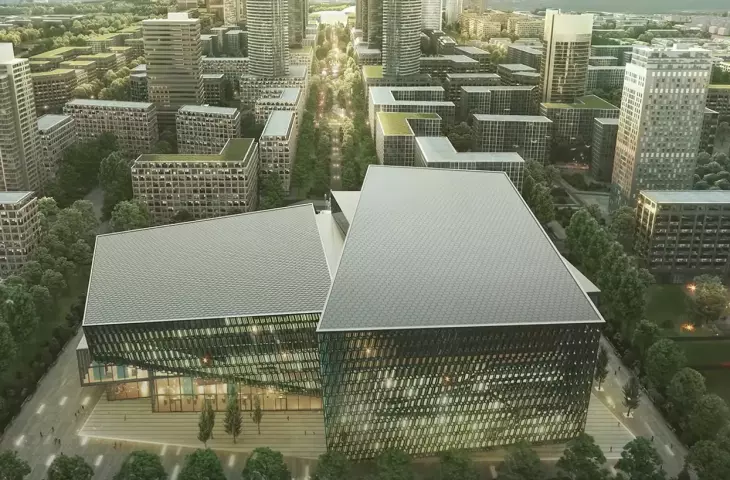Can visions of the city's future be built based on... plagiarism? This question is worth asking while looking at the visuals from the spot promoting the "New City" project - an idea for a new district of Krakow located in the area of Płaszów and Rybitwy.
Plagiarism in architecture is nothing new. Two years ago in the Polish "architecture world" there was a buzz about the use of the visualization of the Horizone Studio project as an example of the possible realization of the Disco Polo Music Center in Michałów, which was described by Katarzyna Jagodzińska on architekturaibiznes.pl. The subject returns in the visualizations of the "New City" - the flagship project of the Cracow City Council, which envisages the construction of a modern residential and business district in the area of Płaszów and Rybitwy.
The concept of the "New City"
The controversy growing over the "New City" project is stirring up a lot of emotions in Krakow. Businesses operating in the area, affiliated with the "Rybitwy Cluster" initiative, are protesting against the change of use of the area. The presidential draft for the "Nowe Miasto" Local Development Plan was rejected in the first reading by the Cracow City Council.
The concept of the "New City" is a river topic, from the economic conditions, the direction of the city's development, the proposed urban planning solutions, to the idea of their implementation in such difficult conditions. Attention in all this is drawn to one object in particular, shown in the visualizations.
One of the cultural attractors in the district
© Frame from a film promoting the New City project (Cracow City Hall)
Krakow - Reyjkjavik
The distance between the capital of Malopolska and the capital of Iceland seems to melt away when looking at the visualization of the "New Town". The cultural building proposed in the concept for the area, located in the eastern part of the complex on the main axis of the premise, resembles the realization of The Harpa Concert Hall in Reykjavik, designed by Henning Larsen Architects. Both the layout of the building, with its characteristic separation into two parts, and the solution of the facade itself indicate direct "inspiration" from the iconic idea of the Danish studio.
In response to our question about the use of the design, the Department of Urban Planning, which commissioned the visualization, replied:
In the video promoting the mpzp project of the "New City" area, the design of the Reyjkjavik Opera House by Henning Larsen Architects was not used, because according to the terms of the contract with the external contractor, who drew up the visualization of the designed urban layout on behalf of the municipality. Among other things, the contractor was obligated to meet the following conditions:
1. declares that it will acquire all legally required copyrights, permits and licenses required for the creation of the Spot, together with its component parts, enabling its proper functioning and use, as well as use and disposal by the Ordering Party (...).
2. assures that the Spot will not infringe on the property rights, related rights, or personal rights of third parties.
Spot was ordered to illustrate an example of the urban layout plan being designed, and not a specific appearance of future facilities. This particular visualization shows the main axis of the premise, which on one side ends with an exemplary representative cultural facility (in the foreground), and on the other side with an exemplary sports facility, not a specific facility to be implemented."
How do the authors of the project in Reykjavik react to this response? We asked Mateusz Mastalski of Henning Larsen Architects to comment.
"Using another architectural firm's design is not a best practice in the industry, it is very misleading. Even if we understand that it is a representation of a cultural attractor within the master plan, the project has clearly been used for commercial purposes and can lead people to believe that we were involved in the process of creating the master plan - which was not the case.
(Original: Using another architecture company "s project is not best practice in the industry, it is very misleading. Even though we understand it is a representation of a cultural attractor within a masterplan, the project has clearly been used for commercial purposes and might lead people to believe we were involved in the masterplan process - which we were not.)
Harpa Concert Hall in Reykjavik
Photo by Ivan Sabljak | © Wikimedia Commons CC-BY SA 3.0.
plagiarism does not bode well
Even if an Icelandic building was used as an example, rather than a specific object to be implemented, it's hard not to ask the question: really, in the context of the image problems of the "New City," shouldn't the Authority look more carefully at such details? The use of a design by a Danish studio may suggest its participation in the design process, which is not true, and even the fact that it is only a suggestion in the form of a visualization, and not a concrete plan, will not help here.
The video "Multifunctional green city will be built in the south of Krakow" promoting the concept
© City of Krakow
The basic question still remains whether Krakow, a city aspiring to become a world metropolis, should allow itself such "inspirational borrowings," even in the form of a cultural attractor. The use of Henning Larsen Architects ' design should not happen if the city is really thinking about building a viable global reputation, let alone building a New City.


















